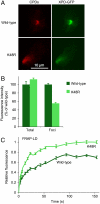Strand- and site-specific DNA lesion demarcation by the xeroderma pigmentosum group D helicase
- PMID: 20876134
- PMCID: PMC2955138
- DOI: 10.1073/pnas.1004339107
Strand- and site-specific DNA lesion demarcation by the xeroderma pigmentosum group D helicase
Abstract
The most detrimental responses of the UV-exposed skin are triggered by cyclobutane pyrimidine dimers (CPDs). Although placental mammals rely solely on nucleotide excision repair (NER) to eliminate CPDs, none of the core NER factors are apparently able to distinguish this hazardous lesion from native DNA, raising the question of how CPDs are circumscribed to define correct excision boundaries. A key NER intermediate involves unwinding of the damaged duplex by transcription factor TFIIH, a reaction that requires xeroderma pigmentosum group D (XPD) protein. This study was prompted by the observation that the ATPase/helicase activity of XPD is necessary for an effective anchoring of this subunit to UV lesions in mammalian nuclei. The underlying mechanism by which XPD impinges on damaged DNA has been probed with a monomeric archaeal homolog, thus revealing that the collision with a single CPD inhibits the helicase but stimulates its ATPase activity. Restriction and glycosylase protection assays show that the XPD helicase remains firmly bound to a CPD situated in the translocated strand along which the enzyme moves with 5'-3' polarity. Competition assays confirm that a stable complex is formed when the XPD helicase encounters a CPD in the translocated strand. Instead, the enzyme dissociates from the substrate after running into a CPD in the complementary 3'-5' strand. These results disclose a damage verification and demarcation process that takes place by strand-selective immobilization of the XPD helicase and its conversion to a site-specific ATPase at DNA lesions.
Conflict of interest statement
The authors declare no conflict of interest.
Figures




Similar articles
-
Strand-specific recognition of DNA damages by XPD provides insights into nucleotide excision repair substrate versatility.J Biol Chem. 2014 Feb 7;289(6):3613-24. doi: 10.1074/jbc.M113.523001. Epub 2013 Dec 14. J Biol Chem. 2014. PMID: 24338567 Free PMC article.
-
Comparative study of nucleotide excision repair defects between XPD-mutated fibroblasts derived from trichothiodystrophy and xeroderma pigmentosum patients.DNA Repair (Amst). 2008 Dec 1;7(12):1990-8. doi: 10.1016/j.dnarep.2008.08.009. Epub 2008 Oct 10. DNA Repair (Amst). 2008. PMID: 18817897
-
The helicase XPD unwinds bubble structures and is not stalled by DNA lesions removed by the nucleotide excision repair pathway.Nucleic Acids Res. 2010 Jan;38(3):931-41. doi: 10.1093/nar/gkp1058. Epub 2009 Nov 20. Nucleic Acids Res. 2010. PMID: 19933257 Free PMC article.
-
Xeroderma pigmentosum and molecular cloning of DNA repair genes.Anticancer Res. 1996 Mar-Apr;16(2):693-708. Anticancer Res. 1996. PMID: 8687116 Review.
-
XPD-The Lynchpin of NER: Molecule, Gene, Polymorphisms, and Role in Colorectal Carcinogenesis.Front Mol Biosci. 2018 Mar 20;5:23. doi: 10.3389/fmolb.2018.00023. eCollection 2018. Front Mol Biosci. 2018. PMID: 29616226 Free PMC article. Review.
Cited by
-
G-quadruplex recognition and remodeling by the FANCJ helicase.Nucleic Acids Res. 2016 Oct 14;44(18):8742-8753. doi: 10.1093/nar/gkw574. Epub 2016 Jun 24. Nucleic Acids Res. 2016. PMID: 27342280 Free PMC article.
-
TFIIH: when transcription met DNA repair.Nat Rev Mol Cell Biol. 2012 May 10;13(6):343-54. doi: 10.1038/nrm3350. Nat Rev Mol Cell Biol. 2012. PMID: 22572993 Review.
-
Lesion Sensing during Initial Binding by Yeast XPC/Rad4: Toward Predicting Resistance to Nucleotide Excision Repair.Chem Res Toxicol. 2018 Nov 19;31(11):1260-1268. doi: 10.1021/acs.chemrestox.8b00231. Epub 2018 Oct 22. Chem Res Toxicol. 2018. PMID: 30284444 Free PMC article.
-
Slowly progressing nucleotide excision repair in trichothiodystrophy group A patient fibroblasts.Mol Cell Biol. 2011 Sep;31(17):3630-8. doi: 10.1128/MCB.01462-10. Epub 2011 Jul 5. Mol Cell Biol. 2011. PMID: 21730288 Free PMC article.
-
Single-molecule studies of helicases and translocases in prokaryotic genome-maintenance pathways.DNA Repair (Amst). 2021 Dec;108:103229. doi: 10.1016/j.dnarep.2021.103229. Epub 2021 Sep 20. DNA Repair (Amst). 2021. PMID: 34601381 Free PMC article. Review.
References
-
- Mitchell DL. The relative cytotoxicity of (6-4) photoproducts and cyclobutane dimers in mammalian cells. Photochem Photobiol. 1988;48:51–57. - PubMed
-
- Jans J, et al. Powerful skin cancer protection by a CPD-photolyase transgene. Curr Biol. 2005;15:105–115. - PubMed
-
- Friedberg EC, et al. DNA Repair and Mutagenesis. Washington, DC: American Society for Microbiology; 2006. pp. 865–894.
Publication types
MeSH terms
Substances
LinkOut - more resources
Full Text Sources
Molecular Biology Databases
Research Materials

